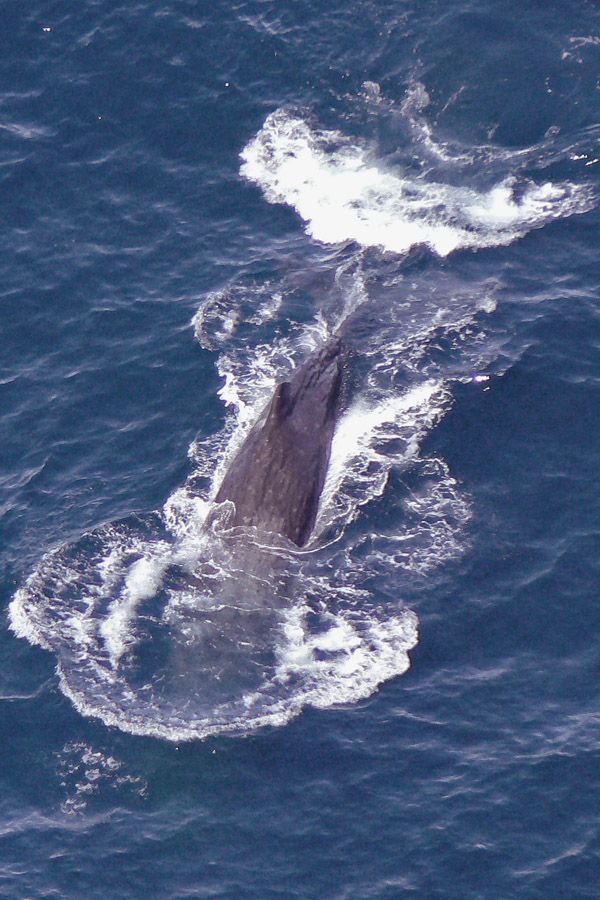
The Sperm Whale – Record Holder in Deepsea Diving
Have you noticed how we whales are all clearly different from one another? With a length of 20 metres, and a weight of 55,000 kg, I am the largest representative of the toothed whales. I only have teeth in my lower jaw; in my upper jaw, there are about 40 holes. The teeth in my lower jaw are about 20 cm long, barrel shaped, and exactly the same size. They fit exactly into the holes in my upper jaw.
But my most important trait is my ability to dive to extreme depths. Thousand metre dives are no problem for me. Sometimes, I even dive to a depth of 3,000 metres. What is wrong? Oh, you’re trying to work it all out! Don’t you trust your results? It’s really true! With every ten metres of increased depth that I dive, there is an additional pressure on my body of one atmosphere. Since I dive at a vertical speed of 7 to 8 km/h, I even have to cope with an extra pressure of more than one atmosphere in my own body – from head to tail, I am 15 metres long. At 1,000 metres, the pressure climbs to 101 atmospheres. That amounts to 101 kg of pressure on every square centimetre of my body. That’s the same as if you had to bear the weight of a heavy-weight boxer on your fingernail. But you’re wondering about something else – How do I deal with diver’s disease – “the bends”? Don’t worry; there’s no danger. My master builder figured out all these details, and equipped me accordingly. I’d like to tell you about it:
You probably think that the deep-diving whales (sperm whale, the northern bottle-nose whale, the rorquals), who can effortlessly spend an hour and a half under water, must have enormous lungs. But, in fact, the opposite is true. Compared with our body size, we have remarkably small lungs. Humans have a lung volume about 1.76% of body size. Elephants’ lungs are 2.55% of body volume. But our corresponding values are much smaller: for me, 0.91%, blue whale 0.73%, northern right whales, 0.65 %. We however, by means of a whole array of mechanisms, utilise our lung capacity much more intensively than land mammals do. For instance, we have substantially more small air chambers. Our blood has 50% higher level of haemoglobin than human blood. Thus we have a much higher capability to transport oxygen. You utilise only 10 to 20 % of your breathed air for energy, but we utilise between 80 and 90%. You see, when we take a breath, it is as effective as if you were to breathe eight times.
And we can prepare for diving differently from any other mammal. Part of that preparation comes from a special capability that the Creator gave us, which enables our muscles to store oxygen in a unique way. Behind that capability are unique organic construction methods and special physiological equipment. Now you can just imagine how I prepare myself for a deep dive. Without haste or stress, I go through a ten-minute long breathing phase, and fill all my oxygen storage capacity. It is easy to remember: for every minute of diving, I prepare myself with one breath. If I take 60 breaths, I can spend about three quarters of an hour at 1000 metres depth. It takes me about 15 minutes to descend and ascend, which easily leaves me 45 minutes at depth.
There is another important difference you should know about: when you dive, 34 % of your oxygen comes from your lungs, 41 % from your blood, and 25 % from your muscles and tissues. For us, it is fundamentally different: only 9% comes from our lungs, 41 % from our blood, leaving 50 % from muscles and tissues. Underwater, therefore, our lungs only play a subordinate role.
Now you probably ask: how do our lungs respond if they are exposed to such crushing pressures? Don’t our lungs just fall in on themselves like a wet sack and collapse? In all land mammals, it is only the windpipe and the large bronchial tubes that are equipped with supporting rings, so that they are able to remain open while inhaling. You have seen this kind of reinforcement on the suction hose of your vacuum cleaner. But for whales, the Creator provided this kind of reinforcement into the smallest branches of the bronchial tree. In this way, our air passages simply cannot be collapsed. In addition, this construction allows for quick ventilation of our lungs.
In order to give us the longest possible diving time, the Creator also gave us an incomparable energy conservation programme. During a dive, our heart beats only half as rapidly as it does on the surface. Nonessential regions or parts of our body can be more or less shut off from the circulation system. The blood stream is redirected and regulated by a system of vein closure muscles. The whole thing works somewhat like a network of one-way streets. During the diving phase, only important organs, such as the brain, the heart, and the tail structure, are provided with oxygen. An essential part of our diving technique is the so-called miracle network (rete mirabile), which the Creator built into only us whales. Your scientists have not yet figured out all of its complex functions. But the miracle network plays a central role in oxygen management and pressure equalisation. (...)
The sperm whale continues: Our Nose – Not on the Face, but On Top of the Head
* quotes from the book "If Animals Could Talk"









